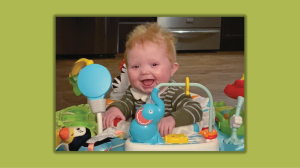A Revolution for Pediatric Organ Transplant
In 2021, a baby boy named Easton Sinnamon was the first person in the world to receive a combination heart transplant and allogeneic processed thymus tissue implantation. Six months later, a video showed Easton smiling and playing in a high chair, and tests indicated that the processed thymus tissue was working: building the T cells needed for a well-functioning immune system.
The hope is that Easton, who was born with severe heart defects and a deficient thymus, can be completely tapered off anti-rejection drugs, which transplant recipients normally take for life.
This landmark procedure has the potential to eliminate the need for anti-rejection medications for all organ transplants in the future.
That success would not have been possible without initial funding from The Hartwell Foundation, said Louise Markert, MD, PhD, professor emeritus of pediatrics, who pioneered the processed thymus tissue implantation method at Duke.
Starting in 1991, Markert and colleagues used the procedure successfully in clinical studies that helped more than 100 babies without a thymus who had nowhere Investigators else to turn. “Without a thymus you’re really going to die,” she said. “The body’s T cells need to go to school in the thymus to learn how to protect from infection.” Several of the babies she helped in this way are now in their 20s and doing well.
In 2011, Hartwell’s president, Fred Dombrose, PhD, dropped by Markert’s research laboratory after learning about her work during a Duke campus visit. He encouraged her to apply for a Hartwell Individual Biomedical Research Award.
In her application, Markert envisioned revolutionizing pediatric organ transplantation. Children who receive heart, lung, or liver transplants must take immunosuppressants for the rest of their lives to prevent their immune systems from attacking and rejecting the transplant. The medications carry the risk of infections, tumors, kidney damage, and heart disease. What if her thymus procedure could be used to train the children’s bodies to accept the new organ, preventing all those complications?
In her Hartwell application, Markert proposed to implant both a liver and thymus from the same donor into rat models.
That plan turned out to be much too ambitious for a three-year project, she said. The team successfully implanted thymuses but not livers. “What we initially set out to do didn’t work, but this whole program that we ended up pursuing would not have existed without that Hartwell support in the beginning,” Markert said. “We learned a lot as we went along.”
She found the quarterly meetings with The Hartwell Foundation representatives invaluable. “What a good model to help people who are getting started in a new area of research!” she said. “The foundation representatives were very knowledgeable and helpful through the whole process.”
The work completed with Hartwell support yielded a key publication in the journal JCI Insight. “We showed in rats where we did not have full donor matching, that we could achieve tolerance to the donor thymus, so we didn’t need long-term immunosuppressive drugs. That was a big deal,” Markert said.
After many more years of work from Markert’s team, in 2016 Duke licensed the thymus procedure to
Enzyvant Therapeutics, GmbH for development, paving the way for its U.S. Food and Drug Administration approval in 2021, and Easton’s groundbreaking heart and thymus transplant.
“Without The Hartwell Foundation giving us the start, we wouldn’t have done any of the rest of the research. The Hartwell Foundation was key to this tremendous success for organ transplantation,” Markert said. “It ended up taking 10 years, but we achieved our original goal.”



